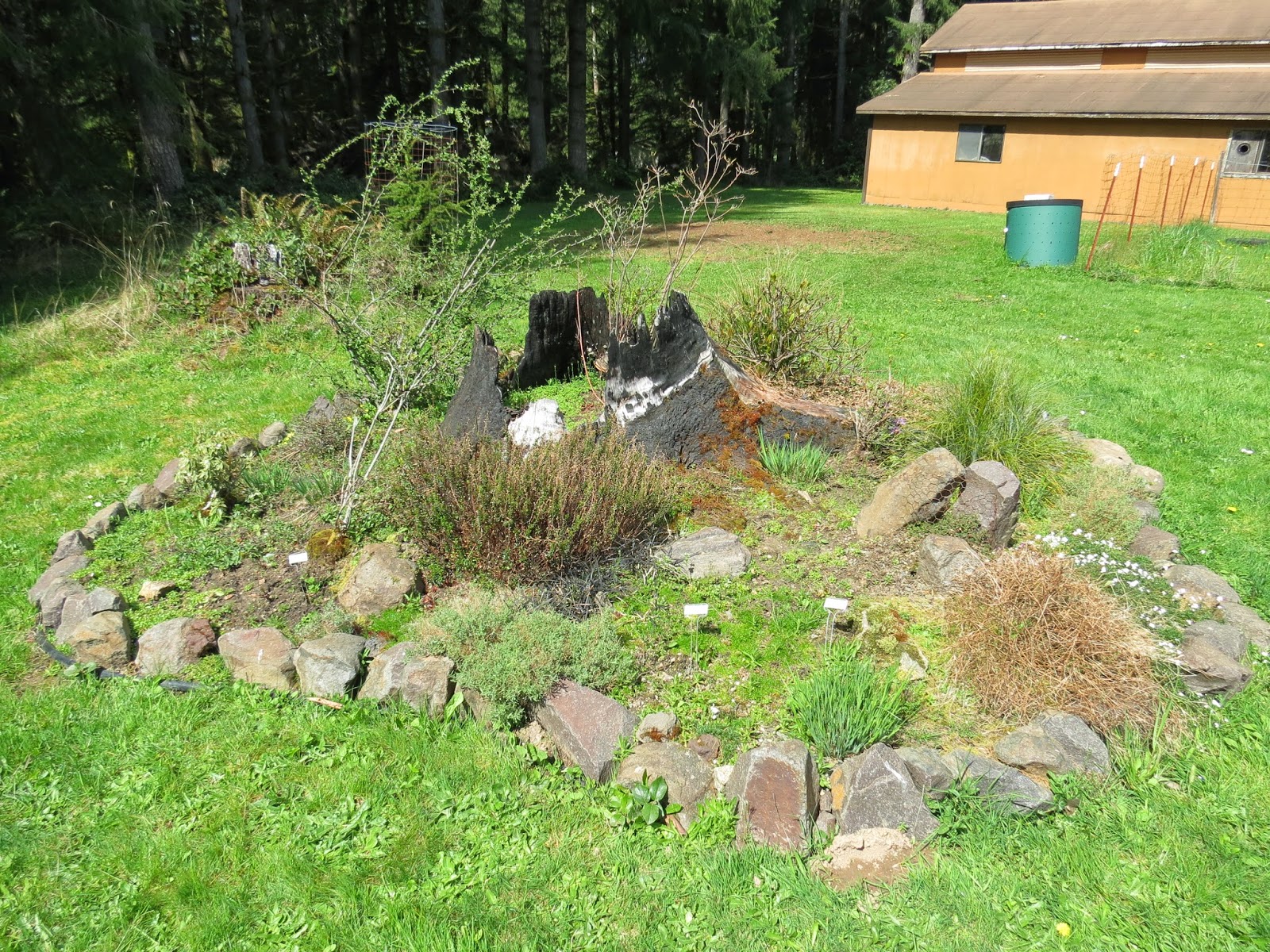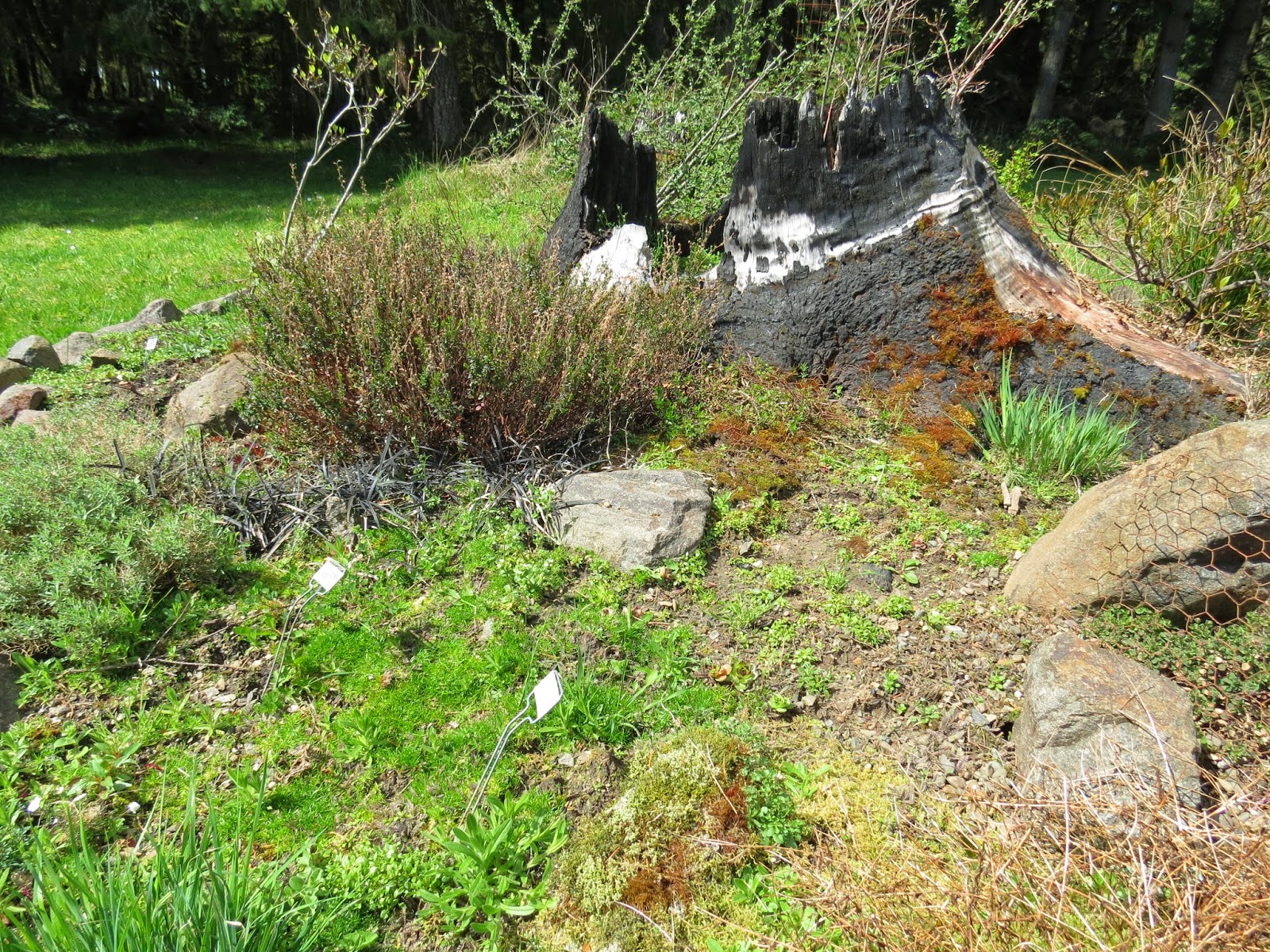Getting Re-acquainted, Part V
This bed is referred to as Stump St. Helens. We cut the tree down to provide more sun in that area and attempted (futilely) to burn the stump away. The result was a hollowed-out shell with a pit a foot or two below the surrounding soil surface, bearing a remarkable resemblance to the volcano. Some time later, we found a deciduous azalea cultivar called 'Mount Saint Helens' and Stump St. Helens was born.
For the first few years, Stump St. Helens erupted every spring with coral pink flowers with an orange flair (and people say pink and orange don't belong together), but the soil we used to fill the stump was less than ideal for an azalea and as the high level of organic matter broke down and sunk lower and lower, the azalea gradually lost vigor. The deer seemed to start attacking it more, as well. I also believe that the high pH of the residual wood ash inside the stump may be contributing to the decline of the azalea.
Our poor watering habits have nothing to do with it though, nothing at all.
...Was that last bit believable? If so, you might want to check if the word "gullible" is in the dictionary. I've heard from reliable sources that it is not.
Another ground cover in this bed is the super-hardy Hutchinsia alpina, a wonderful small-scale ground cover that grows only 2-3 inches tall with finely-textured, emerald-green leaves and small white flowers held on 4 inch stems almost year round. At peak bloom the flowers nearly cover the foliage.
 |
Since this bed is named after Mt. St. Helens, what could be more appropriate than some natives collected near the mountain (outside of the national monument, of course)? The plant below is Penstemon rupicola, a glaucous-leaved evergreen species forming shrubby mats a few inches tall. It's loaded with flower buds this year.
Another native, evergreen mat-forming penstemon, Penstemon cardwellii, has not benefited from the protection that the above specimen has. This one is more exposed to the deer. They munch on it a bit, but what is more damaging is their hooves breaking the brittle stems on their way to strip the azalea.
This sad specimen is Rhododendron 'PJM'. Like some of the other rhodies I've tried (see post here), this cultivar is not deer-resistant. It seems I may have to resign myself to growing the more typical hybrids with larger, more leathery leaves. Don't deer read gardening books? They aren't supposed to like rhodies! Azaleas, sure, but not rhodies! 'PJM' definitely has to go.
All the brown on this side of the stump is the frighteningly aggressive Rubus pentalobus, or creeping raspberry. Yet another experiment turned into a monster worthy of a mad scientist. It would be fine in a larger area where it can spread unchecked, but in this small bed it really is too robust. The frost this winter knocked the foliage back, but it's quickly leafing out.
Another rhododendron that is not immune to deer browse, Rhododendron 'Bob's Blue'. At least this one has developed a canopy of deer-browsed twigs under which it can successfully bloom. I'm confounded by the deer eating this and 'PJM'. 'PJM' especially has oddly fragrant foliage (not bad, somewhat spicy), which I had thought would deter the deer. They never touch the Rhododendron impeditum, which has a similar fragrance, but then that species also has smaller, tougher leaves.
This dwarf mountain hemlock, Tsuga mertensiana, is fenced not because the deer eat it, but to prevent the bucks from rubbing their antlers on the bark. I may risk removing the cage this year as it has grown denser and should be less appealing to bucks with itchy antlers.
The edge of the woods between our property and the junk yard next door. Several large stumps from the previous logging were dug out and piled here to help block the view of the neighbors house, but doesn't quite cover it when viewed from our house. We've been working on planting the edge of the woods to block more of the view.
Garrya elliptica, planted on the edge of the woods, is caged until it outgrows the deer. Like the camellia, garrya seems to be winter browse for the deer.
One of the few outdoor areas safe from the deer, this fenced area was the location of our first vegetable garden after moving to this property. The soil in this spot is awful, but that doesn't matter because it is now used as a nursery area for potted plants waiting to be planted out.
They huddle close together, all trying to keep as far away from the fence as possible in fear of the deer.
Our current vegetable garden has better soil and more sunlight (or it did before we cut down the trees around the old garden site, now I'm not sure).
These raised beds are made of cinder blocks with rebar running through them. Each bed has a connection for drip irrigation.
Into the woods, which make up at least half of the property. This is one of my favorite native mosses, Climacium dendroides, or tree moss. It forms lush cushions on the forest floor.
It gains its name from the tree-like shape of the individual stems.
This is what most of the woods look like. The trees are almost all Douglas firs. There is very little variety in the trees as this was most likely former Weyerhaeuser land. The western sword ferns moved in fast enough, though. They form an almost solid field of 4 foot tall fronds beneath the trees. It's fun to wade waist deep through the ferns. It's been fascinating growing up here and watching the understory develop as small trees and shrubs grow above the ferns and new species move in.
And that's where I'm gardening for the near future. It's not glamorous, or even very attractive, and it lacks even the saving grace of many geek-worthy plants, but it's mine and I'll do what I can to improve it. At least I can add cool plants! The main goal for this spring and summer is to procure cool trees and large shrubs for the cleared areas. But trees are usually sold as relatively large (and expensive plants), so I'm on the lookout for places selling smaller (and cheaper) specimens. I also plan to add screening plants along the road and plant the areas recently reworked around the house. Luckily I've finally found out about all the cool specialty nurseries in the Pacific Northwest that I didn't really know about when I moved away 2 years ago. This is going to be a fun year, but potentially dangerous for my wallet.





















When you come down this way you'll need to stop at Means Nursery out Highway 30, past Cistus and just across from Joy Creek. It's totally random but you can find some grea deals there, like recently a magnolia for just $9.99' and it was already 8ft tall.
ReplyDeleteMy Xerophyllum tenax is still in the single rosette stage, I want it to stay there as I don't have room for the huge plant you show!
Thanks! I vaguely remembered hearing of a nursery like that and couldn't remember the name or where it was. I can do a loop trip of Joy Creek, Cistus, and Means.
DeleteXerophyllum are supposed to have fibrous root systems, so theoretically it could be possible to divide them. Maybe if I get another as a backup I'll try dividing my big clump. It's not huge, maybe a couple feet high and wide.
I'm loving your garden tour!
ReplyDeleteThanks, Peter!
Delete